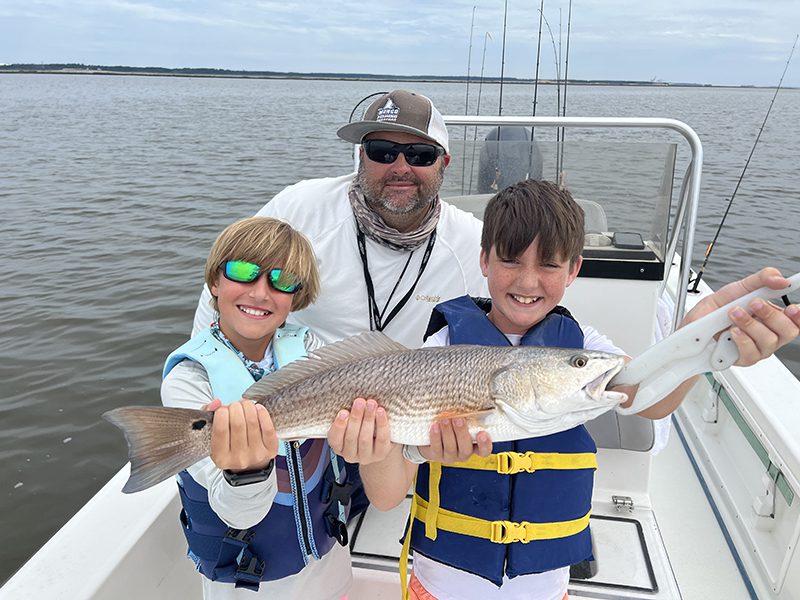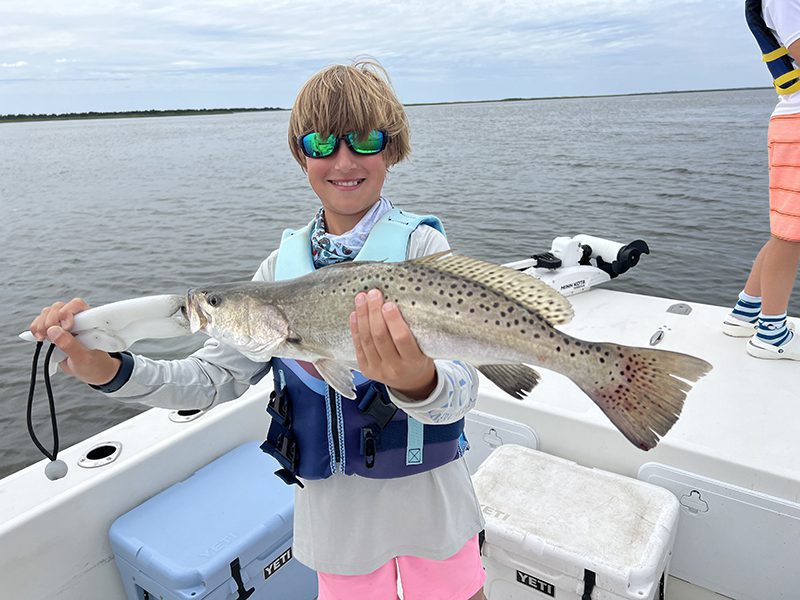Tidelines – July 2022
The standard two-hook rigs with cut shrimp can make a trip when you have young kids onboard, but on our morning with Capt. Tommy Mungo of Mungo Fishing Charters out of the Carolina Beach area, he opted to leave that tackle home and put a little pressure on Ethan (my 10-year-old) and his buddy Mason to successfully cast and retrieve.
Some kids seem to be born with a love of fishing, and from a young age they show the focus and patience that eludes many an adult. My kids, as has been documented in Tidelines through the years, aren’t those kids, so I both liked Tommy’s idea to ask the boys to work soft plastics for our morning half day trip out of Fort Fisher and was also a little wary.

Ethan Hurley (right) with the 24″ red drum that he landed on a live menhaden sitting just off a grass line in the Cape Fear River. He was fishing with friend Mason (left) and Capt. Tommy Mungo (center) of Mungo Fishing Charters.
Tommy told us we would be headed to the outside of the rock wall to find pogies for some Carolina rig fishing later in the morning, but on the way, he had a spot that had just recently been producing some modest summer trout. He put the Power-Pole down to hold us about 15-feet off of a current rip created by the falling tide working its way past some oyster rocks near deeper water.
“Do you see how that water looks different?” Tommy asked both boys as he grabbed a couple of rods already rigged with DOA shrimp.
“I want you to cast to near that line or on the other side of that line. Then count to ten because you have to give the bait enough time to get on the bottom. Flip the bail and give the bait some pops for movement,” he explained while giving one of the two rods a demonstration of the popping motion he was hoping the boys would be able to mimic.
Mason was quick to follow instructions and follow them on his own, getting his bait out to the zone Tommy had identified, an area upcurrent that would allow for the ten second fall and have the bait at the right depth before drifting through the main target zone.
Ethan needed some casting tip reminders, as Tommy quickly identified since he has a lot of practice (and very much enjoys) taking kids fishing who need a little help to succeed.
Tommy reminded Ethan of how far from the rod tip the bait should be positioned for the cast, how to hold the line with just a finger for a smooth release, to bring the rod back straight over the head and straight behind to help with accuracy, and where in the casting motion to release the finger to get a better distance.
Counting to ten after the bait hits the water and before flipping the bail and starting the retrieve is a long time to ask anyone to wait, so I was doubtful for these two energetic boys. Once again, Mason was quicker to follow instructions and hold off for 10 seconds, while Ethan struggled.
Tommy was confident that Mason’s DOA shrimp was down in the zone, even bouncing off the bottom at times on the retrieve, and that confidence in the bait being deep was confirmed when Mason’s first fish to the landing net was a flounder.
Seeing Mason land a fish made Ethan a little more anxious to catch a fish himself, which meant he had an even harder time counting to ten, but Tommy knows kids and how to help kids succeed, so he exchanged Ethan’s light DOA shrimp with a jerk shad soft plastic on a heavier jig head. The bait’s increased weight meant Ethan no longer had to count to ten—the bait would more quickly get into the strike zone.
The boys found a couple of quick fish, so we were off to find some pogies in the Cape Fear River. Ethan and Mason helped us spot diving birds, they helped us see the flips, and when the swollen cast net dumped about 100 baits in the floor of the boat, the boys quickly got to work transferring them into the livewell.
Kids and bait, Tommy will tell you, almost always make for fun and memories, and Ethan and Mason were living proof as they laughed and cheered each pogie into the circulating water.
The plan Tommy had imagined was playing out well. The boys started with cast and retrieve, and then when they began to be a little impatient, he made the change to get bait and soak some Carolina rigs off a grass line.
Fan casting live and cut pogies along a grass line and then letting the rods sit in rod holders waiting for the rod to bend over gave the kids a break from “working,” and they used that downtime to check (repeatedly) on all our pogies in the livewell. When you’re young, almost anything can become a game, and when Tommy started checking lines and asking for fresh pogies, a game ensued.

Mason Murphy with a trout he hooked near the Fort Fisher rock wall. He was throwing a D.O.A. soft plastic shrimp while fishing with Capt. Tommy Mungo of Mungo Fishing Charters.
Both boys took turns standing at the livewell, and with their eyes closed they used a sharp down-and-up motion to try and hand snag a pogie. The game was interrupted, though, when the left bow line showed a couple of quick ticks and then bent over with drag peeling off.
Ethan was on the rod and began his battle with a red drum. Mason gave support until Ethan brought the 24” fish in, and then a second line went down. The action of the second line showed fish, but it wasn’t obviously saying redfish. When Mason’s fish came in, he had landed his second flounder of the day.
There was more bait soaking, there was more cast-and retrieve efforts, and there was more fish landed. Then we all agreed that it had been a fun morning and it was time to head back to the ramp.
Capt. Tommy Mungo, of Mungo Fishing Charters out of the Carolina Beach and surrounding areas, pulls on his own memories of being a kid learning to fish, as well as his experiences asa a father teaching his own kids. He knows that just as important as catching fish is developing in those kids a love of fishing and an appreciation of being outside, especially in a world where screens are battling all the time to get our kids plugged in.
If you’d like to help your kids (or maybe yourself) on that path to valuing fishing and the natural world, then check Tommy out online at www.mungofishingcharters.com or call him at (910) 616-1238.
Remember, though, that while counting to ten and releasing your finger at the right time on your cast can be helpful, it’s just as important that you have your eyes completely closed when snatching pogies. No cheating, and no double stabs. You only get one quick down-and-up motion to grab that pogie for the captain.
